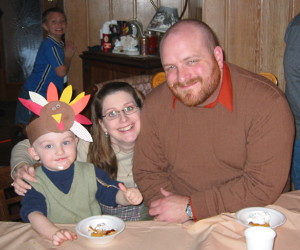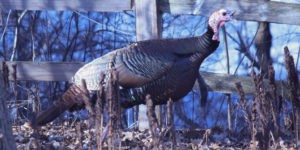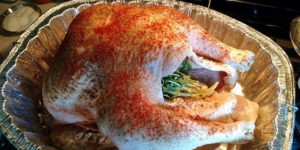Thursday morning came and my Aunt always made us eggs and English muffins. Then she would shoo us out of the kitchen so she could start preparing for dinner. One year, my Uncle wowed the visitors with television programs he had recorded from broadcast TV on his new VCR. It was amazing, you could watch a TV show anytime you wanted AND you could fast forward through the commercials! Soon the table would be stretched out with all the leaves in place and we would start counting the place settings and trying to guess who was coming for dinner. Meanwhile my Dad and Uncle would settle in for that traditional Thanksgiving pastime: watching the football game.
Of course, dinner was always fantastic. My Aunt was a wonderful cook who always made more food than could fit on the table. All the classics made their stop on my plate as we passed it all around the table. Even when you tried to take just a little of everything, your plate still ended up overflowing and you had to take off your belt just to get through it all. Somewhere along the way, my Aunt and I started a tradition of taking a long walk after dinner while everyone else hit the couch for a post turkey nap. Those were special times where I shared all the difficulties of growing up and my Aunt always listened and offered her advice, or sometimes just a sympathetic ear.

When my son was two (and my wife was pregnant) we visited again for Thanksgiving. My cousin still lives in the same house.
Friday and Saturday were spent traversing the countryside visiting other relatives and catching up on how my cousins had changed or grown over the past year. Over the years, catching snakes and turtles in the back yard with my female cousins gave way to concerns about hair and nails. Some of the greatest memories in that old house were the reenactments of the show as we all sang along to the Grease soundtrack on the old turntable.
Finally, Sunday came and with it, the long drive home. It was the same 10-hours, but it always felt like it whizzed by and we were home before we knew it…already anxious for next year when we would get to visit again. Those were truly magical days that I will never forget.
These days, Thanksgiving feels like it is very different, but also very much the same. We are at home now, and I get to play the part of the Dad. I make the pies the day before and hide them. We all watch some football on TV while I time putting the turkey in the oven so dinner is ready at just the right time. Many of my holiday recipes have changed over the years, but the classics are all represented on our table.
Ask anyone and they will tell you, the star of the classic Thanksgiving table is the turkey. It just isn’t Thanksgiving without that special guest. There are so many ways to make a great turkey for your holiday table, but this bird takes a little planning and preparation to get it just right.
The first hurdle is obtaining a bird. Don’t wait until the last minute to buy your turkey, you want to make sure you have plenty of time to get to know each other. These birds are finicky guests and yours may seem cold and unyielding when you first get it home…or it could just be that it is frozen. If you got a fresh turkey, then you can stash it in the fridge and skip down to the next section. But if you got a frozen turkey, you need time to get that bird thawed.
This is a process that you want to take your time with, and keep that bird cold. As it begins to warm up, bacteria can begin to grow. That means that the “leave it on the counter” method is the worst way to go. The outside of the turkey will get warm, while the inside is still frozen, and bacteria loves a warm bird sitting out on the counter. The best bet is to leave it in the fridge to thaw slowly. It should take about 24 hours for every 4-5 pounds of bird. If you got one of those monstrously huge turkeys, it could take almost a week to thaw completely, so plan ahead. If you are shorter on time, drop that bird in some cold water to thaw. That should take about 30 minutes per pound to get there. Even with this method, you are still looking at hours to reach a full thaw. Keep the water cold and change it fairly often until you are sure everything is thawed. If you are sitting there with a frozen bird while your family is watching the parade on TV…start thinking about how you will order a pizza for dinner. This chart from Foodsafety.gov is a good guide for thawing times.
Next, you need to think about how you want to cook that Turkey. There are lots of yummy options to choose from, and we all have our favorites. Although I have never done this myself, I have had deep fried turkey and it is delicious. If you choose to go that route, just keep safety in mind. Hot oil sloshing around over a propane burner is a recipe for disaster. Make sure you leave extra room in the pot so when you put the turkey in, it doesn’t overflow the oil (the turkey will displace more oil than you think). And for crying out loud, whatever you do, don’t do this on the deck or very close to the house. The fire department doesn’t want to come to your house on Thanksgiving.
If you want to brine your turkey, here is a recipe for turkey that I have made for Passover. This makes a very juicy bird that takes some planning ahead so you have time to let it soak in the brine. The one thing to remember when trying this method, a brined turkey will cook a LOT faster than normal. The first time I did this, I was really surprised that my turkey was done so early that day.
Another fun trick is to cook a turkey in a paper bag. Yes, a paper bag like the ones you bring home from the grocery store. If you want to try this, approach with a little caution. Coat the entire inside of the bag with shortening or margarine. Don’t leave any of the bag dry or you might end up with a smoked turkey after all. Once the bag is coated, season the turkey and slide it into the bag. Crimp the bag closed (some large paper clips work well here), then place the whole thing inside a pan deep enough to capture any juices. This method automatically bastes the turkey while it cooks, so it does make a nice juicy bird.
We could sit here and talk turkey until next Tuesday, but let’s get down to some basics that will have you gobbling up the bird this Thanksgiving.
First thing first…make sure you check the inside of the bird in case you have the one with the extra giblets and the neck in there. They are usually in some kind of paper bag that you don’t want to leave in there while you cook it. Remove that extra stuff and place the bird in a large roasting pan. You want to have enough depth to the pan to collect any juices. If you don’t have a pan large enough, you can usually find one of those big disposable foil pans at the grocery store that will work just fine.
You will want to season your bird. Start by sprinkling a little salt and pepper over the top and then feel free to get creative. I often like to put some apple slices or lemon chunks inside the bird along with some fresh herbs like sage and parsley. Next, I will sprinkle some seasonings over the top of the bird. Garlic powder, sage or poultry seasoning, and paprika are good choices here.
The next thing to do is make sure your oven is preheated to somewhere around 325-350°. A lower temp is good, but make sure it is at least 325°. If your oven tends to be less than accurate, set it at 350° to be safe. Next, if your turkey has one of those pop up timer things, just accept that you are going to pretend it isn’t there. Never rely on one of those to tell you anything other than your turkey is probably over cooked and dried out. What you really want to do is get one of those remote probe type thermometers. The kind with the wire so the probe stays in the bird and there is a digital readout on the other end of the wire that stays outside the oven. That way you can monitor the temp of your bird without opening the oven door. Insert the probe into the thickest part of the thigh. But don’t hit the bone since that won’t give you an accurate reading.
Now you are all set to get your turkey in the oven. Just slide that in there and close the door. Don’t worry about basting the bird during cooking. That doesn’t really help much, and it just takes longer to cook since you keep letting all the heat out of the oven every time you open the door. But wait….how will you know when your turkey is done? Plenty of web sites will tell you to plan roughly 20 minutes per pound for how long to have it in the oven. But never rely on time alone to tell you when your turkey is done. My turkeys often seem to take longer than I expect, so the estimates of time are just rough estimates. You really need to watch your thermometer and when it hits 165°, pull that bird out of the oven. As long as you have the thermometer deep in the thigh and not touching the bone, then you should be good and you can feel confident that your turkey is done. Now, here is the next secret to having a juicy bird on the table. DO NOT start carving that bird right away. Throw a sheet of foil over the top and leave it to sit on the counter for about 20-30 minutes. It will continue to cook a little as it sits there, and this gives the juices some time to redistribute in the meat.
I hope your turkey comes out great and you have a wonderful Thanksgiving. Make sure to spend some time with your family, be thankful, and make some memories.





